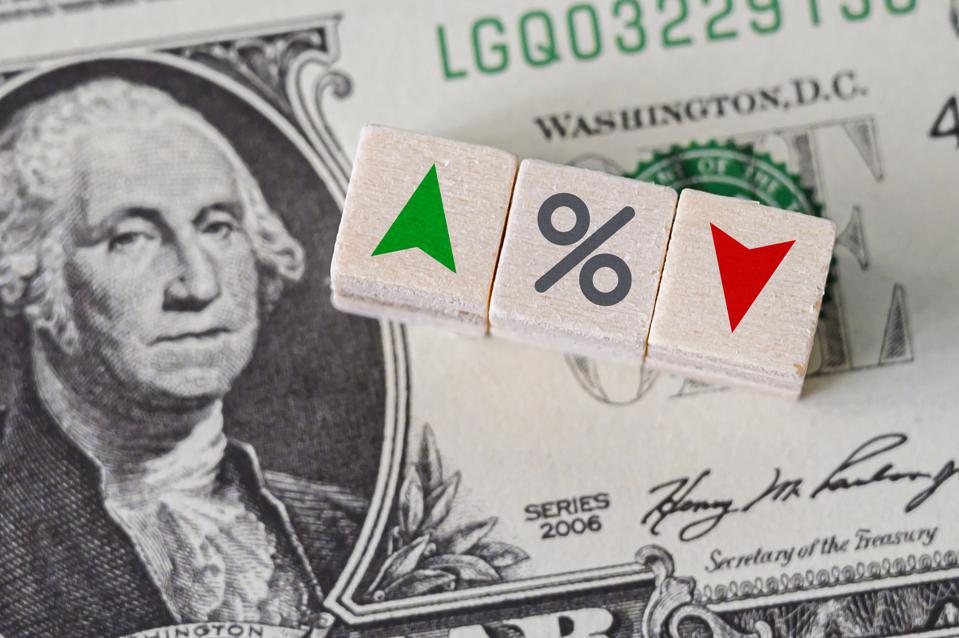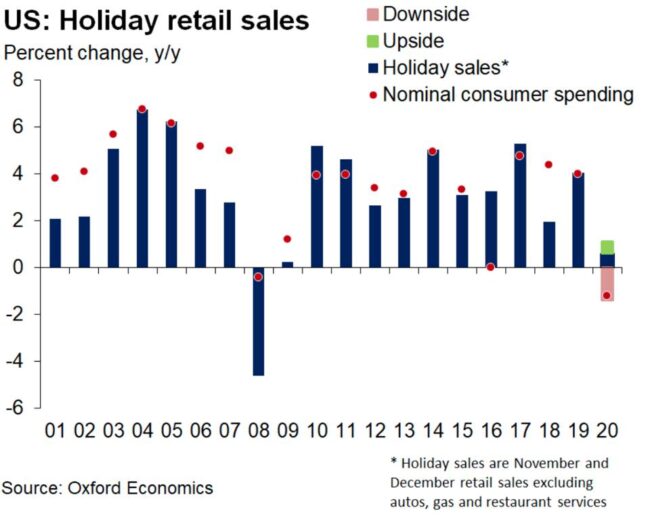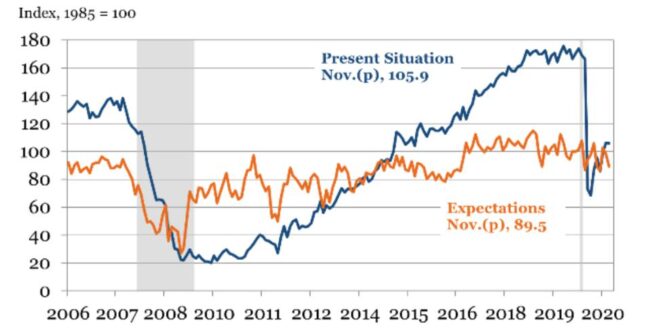Gregory Daco, Oxford Economics Chief U.S. Economist, tracks six metrics to gauge how the economy is performing. In early November he wrote, “The U.S.
Gregory Daco, Oxford Economics Chief U.S. Economist, tracks six metrics to gauge how the economy is performing. In early November he wrote, “The U.S. Recovery Tracker posted its third consecutive decline in the week ended Oct. 23, falling 0.6 points to 79.4. The dangerous cocktail of surging Covid-19 infections and fading fiscal support led to a visible slowdown in economic activity in October, with the tracker falling to its lowest level in 10 weeks.”
While this statement was from three weeks ago, I believe Daco’s Recovery Tracker has probably continued to fall vs. improving due to the increased number of coronavirus cases, hospitalizations and deaths, higher unemployment claims and fiscal stimulus not being renewed.
U.S. Economic Tracker
Daco also tracks the recovery in Europe and not surprisingly its pattren tracks the U.S. very closely. While Europe wouldn’t be expected to give a big assist to the U.S., having another large region of the globe faltering is not helpful.
Eurozone Economic Tracker
Personal Income fell in October
The U.S. Bureau of Economic Analysis reported that personal income in the U.S. fell 0.7% from September to October. While the decline was due to a decrease in government social benefit payments, individuals still had a smaller amount of money to spend. If this trend continues or just stays flat this is something to keep an eye on as we enter the holiday season.
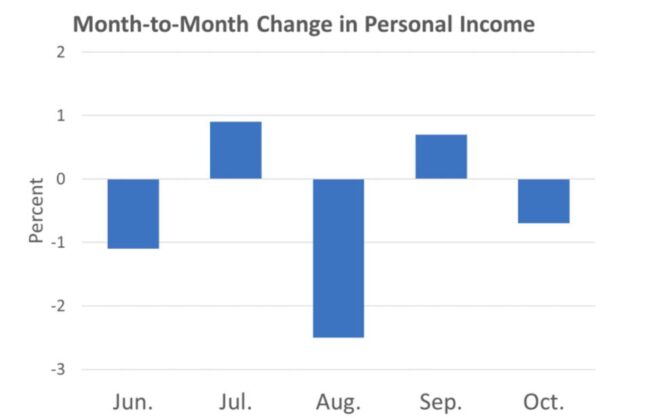
Personal Income, October 2020
Retail sales entering the critical holiday season
Retail and food service sales barely increased from September to October after two strong months in August and September according to the U.S. Census Bureau. Total sales increased 0.3% month-to-month but were up 5.7% year-over-year. While a one-month slowdown does not make a trend, it is something to keep an eye on.
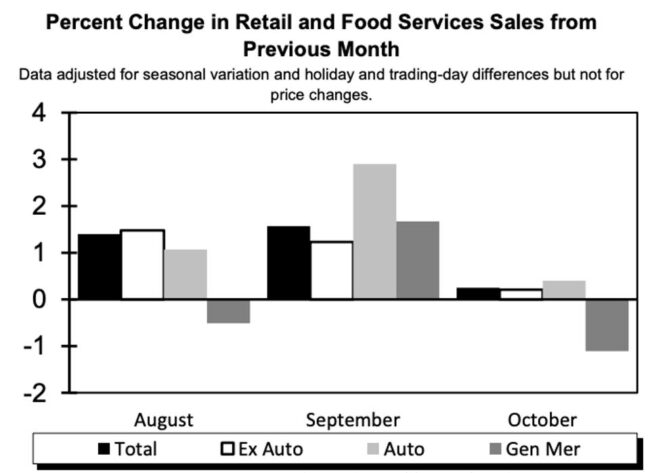
Percent change in retail and food services sales, month-to-month, October 2020
The National Retail Federation pegs this year’s holiday spending increase at 3.6% to 5.2%. This compares to a 4% increase last year and 3.5% on average the past five years. NRF Chief Economist Jack Kleinhenz said, “Given the pandemic, there is uncertainty about consumers’ willingness to spend, but with the economy improving most have the ability to spend. Consumers have experienced a difficult year but will likely spend more than anyone would have expected just a few months ago.”
He added, “After all they’ve been through, we think there’s going to be a psychological factor that they owe it to themselves and their families to have a better-than-normal holiday. There are risks to the economy if the virus continues to spread, but as long as consumers remain confident and upbeat, they will spend for the holiday season.”
However, Daco at Oxford Economics believes holiday spending could rise less than 1% and may even fall year-over-year. This would be due to, “muted employment gains and reduced fiscal aid weighing on incomes. Plus, a worsening Covid-19 outbreak is once again limiting activity across the country.”
He added, “big unknowns include the trajectory of the third Covid-19 wave, the distribution of personal savings across lower- and higher-income families, and higher-income families’ propensity to shift traditional spending on services toward goods” along with, “We can’t sugarcoat it: The US health situation is going from bad to worse, and this will have important consequences on economic activity in coming weeks, especially in the absence of additional fiscal aid.”
Consumer confidence is shaken
The Conference Board’s Consumer Confidence Index declined from 101.4 in October to 96.1 in November. While the Present Situation Index remained essentially flat (down from 106.2 to 105.9) the Expectations Index took a big hit from 98.2 to 89.5.
Lynn Franco, Senior Director of Economic Indicators at The Conference Board commented, “Consumers’ assessment of present-day conditions held steady, though consumers noted a moderation in business conditions, suggesting growth has slowed in Q4. Heading into 2021, consumers do not foresee the economy, nor the labor market, gaining strength. In addition, the resurgence of COVID-19 is further increasing uncertainty and exacerbating concerns about the outlook.”
The Surveys of Consumers by the University of Michigan showed a similar decline in consumer sentiment. While its Current Conditions Index rose slightly (vs. The Conference Board’s slight decline), its Expectations Index tumbled from 79.2 to 70.5. Richard Curtin, Surveys of Consumers Chief Economist, commented, “The resurgence of Covid-19 infections and deaths in the months ahead is likely to promote more firm closures and stay-at-home orders in addition to mandatory wearing of face masks and social distancing. Widespread closures are likely to exact a heavy toll on the economy and cause severe hardships for some households. A delay in federal aid until next year would permit great harm and permanent damage to occur for many households, firms, and local governments. Immediate action by the current administration and Congress is urgently needed to secure the continuation of the economic recovery and to ensure the welfare of all households.”
Source : www.forbes.com

